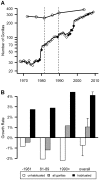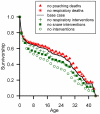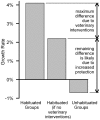Extreme conservation leads to recovery of the Virunga mountain gorillas
- PMID: 21687709
- PMCID: PMC3110611
- DOI: 10.1371/journal.pone.0019788
Extreme conservation leads to recovery of the Virunga mountain gorillas
Abstract
As wildlife populations are declining, conservationists are under increasing pressure to measure the effectiveness of different management strategies. Conventional conservation measures such as law enforcement and community development projects are typically designed to minimize negative human influences upon a species and its ecosystem. In contrast, we define "extreme" conservation as efforts targeted to deliberately increase positive human influences, including veterinary care and close monitoring of individual animals. Here we compare the impact of both conservation approaches upon the population growth rate of the critically endangered Virunga mountain gorillas (Gorilla beringei beringei), which increased by 50% since their nadir in 1981, from approximately 250 to nearly 400 gorillas. Using demographic data from 1967-2008, we show an annual decline of 0.7%±0.059% for unhabituated gorillas that received intensive levels of conventional conservation approaches, versus an increase 4.1%±0.088% for habituated gorillas that also received extreme conservation measures. Each group of habituated gorillas is now continuously guarded by a separate team of field staff during daylight hours and receives veterinary treatment for snares, respiratory disease, and other life-threatening conditions. These results suggest that conventional conservation efforts prevented a severe decline of the overall population, but additional extreme measures were needed to achieve positive growth. Demographic stochasticity and socioecological factors had minimal impact on variability in the growth rates. Veterinary interventions could account for up to 40% of the difference in growth rates between habituated versus unhabituated gorillas, with the remaining difference likely arising from greater protection against poachers. Thus, by increasing protection and facilitating veterinary treatment, the daily monitoring of each habituated group contributed to most of the difference in growth rates. Our results argue for wider consideration of extreme measures and offer a startling view of the enormous resources that may be needed to conserve some endangered species.
Conflict of interest statement
Figures




References
-
- Kapos V, Balmford A, Aveling R, Bubb P, Carey P, et al. Calibrating conservation: new tools for measuring success. Conservation Letters. 2008;1:155–164.
-
- Bruner AG, Gullison RE, Balmford A. Financial costs and shortfalls of managing and expanding protected-area systems in developing countries. Bioscience. 2004;54:1119–1126.
-
- Struhsaker TT, Struhsaker PJ, Siex KS. Conserving Africa's rain forests: problems in protected areas and possible solutions. Biological Conservation. 2005;123:45–54.
-
- Nichols JD, Williams BK. Monitoring for conservation. Trends in Ecology & Evolution. 2006;21:668–673. - PubMed
Publication types
MeSH terms
LinkOut - more resources
Full Text Sources
Research Materials

